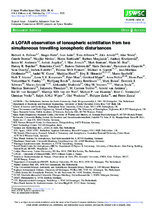| dc.contributor.author | Serylak, Maciej | |
| dc.contributor.author | Fallows, Richard A. | |
| dc.contributor.author | Forte, Biagio | |
| dc.date.accessioned | 2021-02-08T08:19:55Z | |
| dc.date.available | 2021-02-08T08:19:55Z | |
| dc.date.issued | 2020 | |
| dc.identifier.citation | Maciej S , Fallows RA, Forte B, Astin I, Allbrook T, et al. 2020. A LOFAR observation of ionospheric scintillation from two simultaneous travelling ionospheric disturbances. J. Space Weather Space Clim. 10, 10. | en_US |
| dc.identifier.issn | 2115-7251 | |
| dc.identifier.uri | https://doi.org/10.1051/swsc/2020010 | |
| dc.identifier.uri | http://hdl.handle.net/10566/5846 | |
| dc.description.abstract | This paper presents the results from one of the first observations of ionospheric scintillation
taken using the Low-Frequency Array (LOFAR). The observation was of the strong natural radio source
Cassiopeia A, taken overnight on 18–19 August 2013, and exhibited moderately strong scattering effects
in dynamic spectra of intensity received across an observing bandwidth of 10–80 MHz. Delay-Doppler
spectra (the 2-D FFT of the dynamic spectrum) from the first hour of observation showed two discrete parabolic
arcs, one with a steep curvature and the other shallow, which can be used to provide estimates of the
distance to, and velocity of, the scattering plasma. A cross-correlation analysis of data received by the
dense array of stations in the LOFAR “core” reveals two different velocities in the scintillation pattern:
a primary velocity of ~20–40 ms 1 with a north-west to south-east direction, associated with the steep parabolic
arc and a scattering altitude in the F-region or higher, and a secondary velocity of ~110 ms 1 with a
north-east to south-west direction, associated with the shallow arc and a scattering altitude in the D-region.
Geomagnetic activity was low in the mid-latitudes at the time, but a weak sub-storm at high latitudes
reached its peak at the start of the observation. | en_US |
| dc.language.iso | en | en_US |
| dc.publisher | The Journal of Space Weather and Space Climate | en_US |
| dc.subject | Ionospheric scintillation | en_US |
| dc.subject | Travelling ionospheric disturbances | en_US |
| dc.subject | Instability mechanisms | en_US |
| dc.subject | Radio waves | en_US |
| dc.subject | Low-frequency array | en_US |
| dc.title | A LOFAR observation of ionospheric scintillation from two simultaneous travelling ionospheric disturbances | en_US |
| dc.type | Article | en_US |

